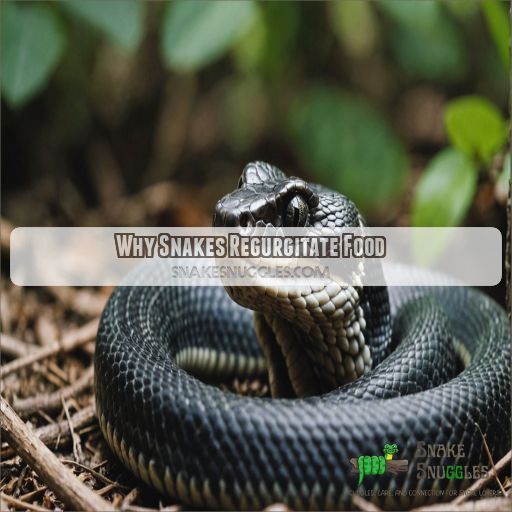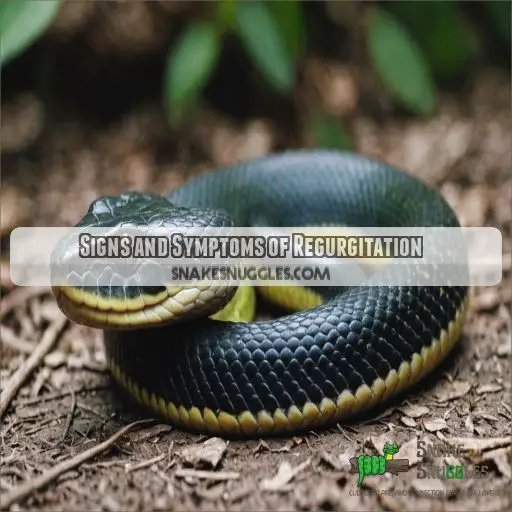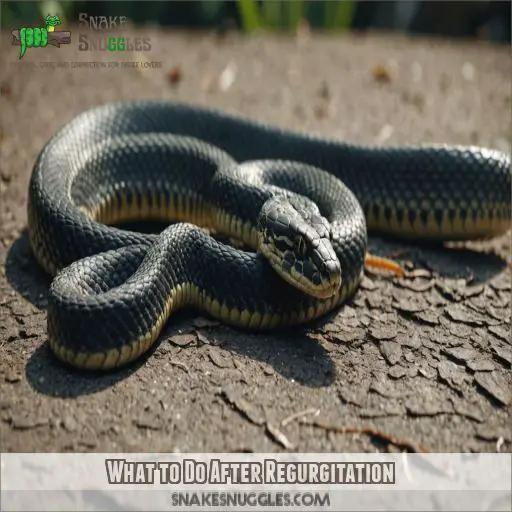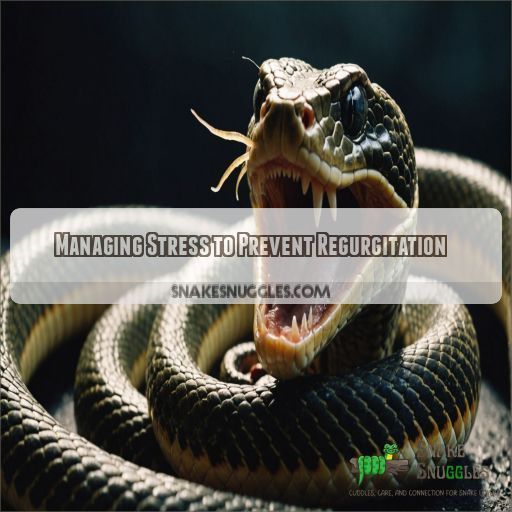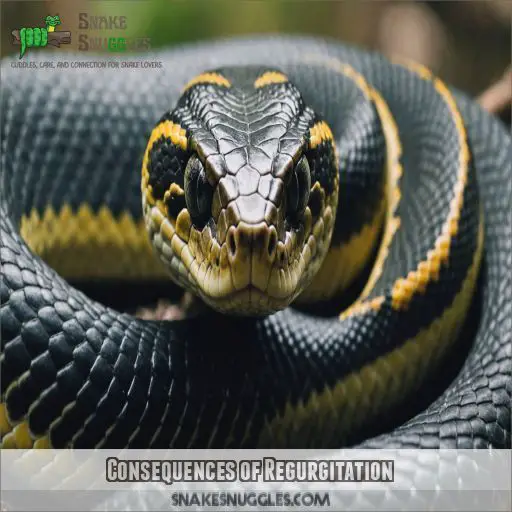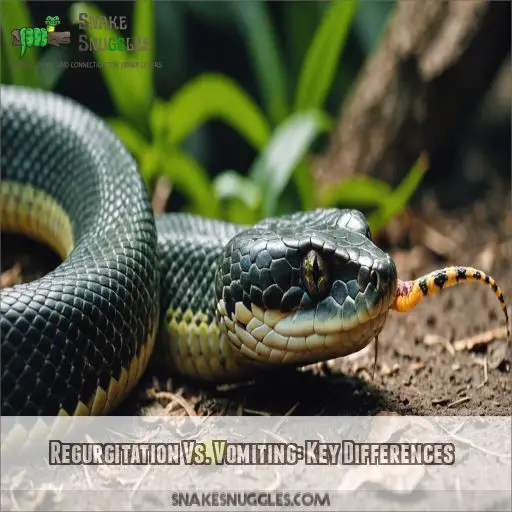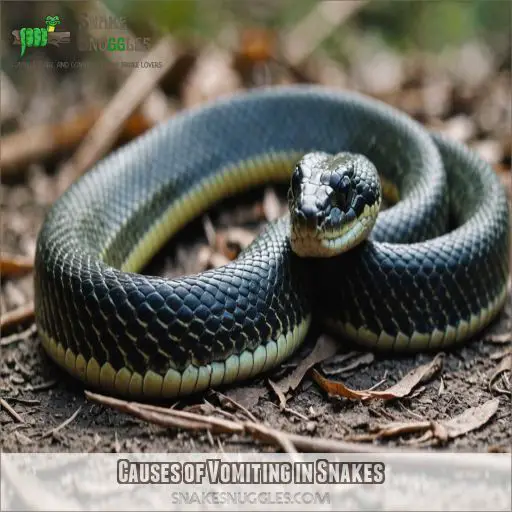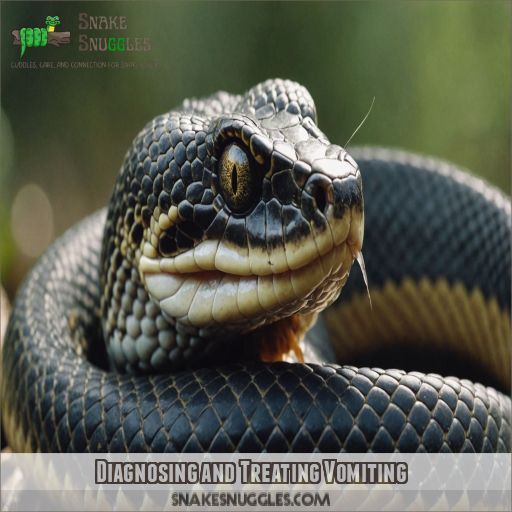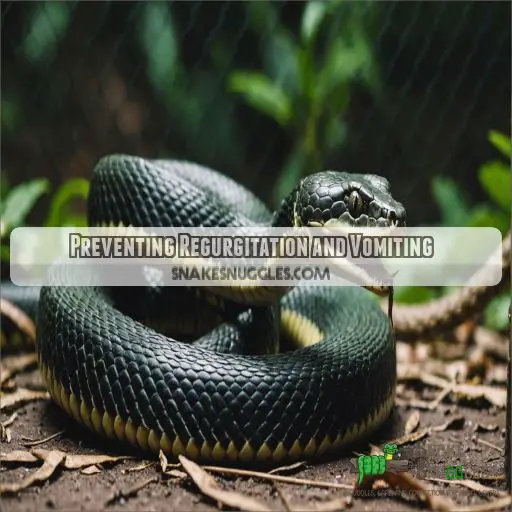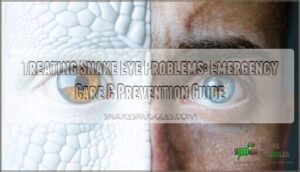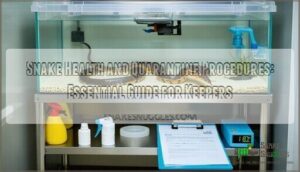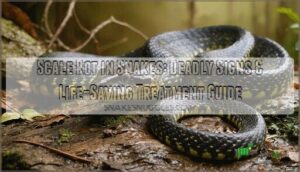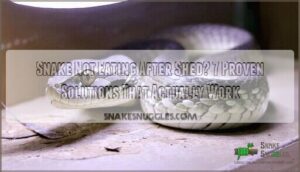This site is supported by our readers. We may earn a commission, at no cost to you, if you purchase through links.
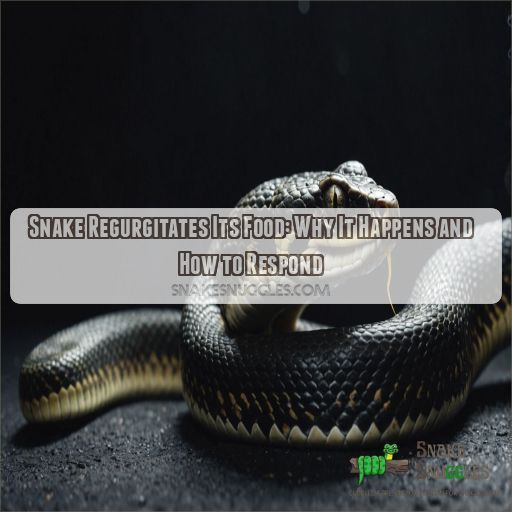 The dreaded dinner reversal – your snake regurgitates its food! Don’t worry, it’s not uncommon.
The dreaded dinner reversal – your snake regurgitates its food! Don’t worry, it’s not uncommon.
Stress and handling issues are often the culprits, especially if your snake is handled too soon after eating.
Environmental factors like temperature fluctuations, inadequate humidity, and insufficient lighting can also cause digestive issues.
If your snake regurgitates its food, give it a 14-day break from feeding to recover.
Provide a stress-free environment, ideal temperature, and humidity levels, and consider adding a reptile-specific probiotic to its water.
Table Of Contents
- Key Takeaways
- Why Snakes Regurgitate Food
- Signs and Symptoms of Regurgitation
- What to Do After Regurgitation
- Managing Stress to Prevent Regurgitation
- Consequences of Regurgitation
- Regurgitation Vs. Vomiting: Key Differences
- Causes of Vomiting in Snakes
- Diagnosing and Treating Vomiting
- Preventing Regurgitation and Vomiting
- Frequently Asked Questions (FAQs)
- Why did my snake regurgitate its food?
- What do I do if my snake regurgitates?
- How long to wait after snake regurgitates?
- What is the difference between vomiting and regurgitation in snakes?
- How often do snakes regurgitate their food in captivity naturally?
- Can certain snake species regurgitate food more easily than others?
- What role does humidity play in snake regurgitation issues overall?
- Are younger snakes more prone to regurgitation than adults generally?
- Can regurgitation be a sign of a snakes approaching shedding?
- Conclusion
Key Takeaways
- If your snake regurgitates its food, don’t panic! Give it a 14-day break from feeding to recover, and provide a stress-free environment with ideal temperature and humidity levels. You can also add a reptile-specific probiotic to its water to help rebalance its gut bacteria.
- Regurgitation is often a stress response, so it’s essential to minimize handling and create a calm atmosphere for your snake. Think of its enclosure as a relaxing spa, and add enrichment ideas like climbing structures or hiding spots to keep your snake engaged.
- Keep an eye out for signs of underlying health issues, such as lethargy, loss of appetite, or changes in stool quality. If you suspect a problem, consult a reptile-savvy veterinarian to rule out any underlying conditions. Remember, prevention is key, so stay vigilant and catch any potential problems early.
- To prevent regurgitation and vomiting, ensure proper prey size and type, maintain optimal environmental conditions, limit handling and stress, and monitor your snake’s health and behavior. By following these tips, you can reduce the likelihood of regurgitation and vomiting episodes and help your snake thrive.
Why Snakes Regurgitate Food
Ever wonder why snakes sometimes spit out their meals? Well, it’s not because they’re picky eaters. Snake regurgitation, or food spitting, often boils down to stress and sensitive tummies.
Stress and Handling Issues
Stress and handling play a huge role in snake regurgitation.
Snakes are sensitive creatures of habit, and frequent handling, especially right after feeding, can stress them out.
To avoid this, limit handling for a few days before and after feeding.
Also, create a calm, familiar environment with proper heat and humidity.
Keep their cage in a low-traffic area to minimize disturbances.
These simple steps can help prevent regurgitation and keep your slithery friend happy and healthy.
Environmental Factors
Now that we’ve covered stress and handling issues, let’s talk about environmental factors that can cause your snake to regurgitate its food. Your snake’s enclosure is its home, and just like you, it needs a comfortable environment to thrive. Here are some factors to keep in mind:
- Temperature fluctuations can cause digestive issues
- Inadequate humidity levels can lead to dehydration
- Insufficient lighting can disrupt your snake’s circadian rhythms
- A substrate that’s too damp or dirty can harbor bacteria
- An enclosure that’s too small can stress your snake out
Underlying Health Problems
Now, let’s tackle the not-so-fun part — underlying health problems.
If your snake regurgitates frequently, it may be a sign of a parasite infection, liver disease, kidney issues, bacterial infections, or viral infections.
Don’t panic! Consult a reptile-savvy vet to rule out any underlying conditions.
Your snake’s health is worth it, and a professional can help you get to the bottom of things.
Signs and Symptoms of Regurgitation
When your snake regurgitates its food, it can be a stressful and worrisome experience for both you and your pet. To respond effectively, it’s important to recognize the signs and symptoms of regurgitation, which can be easily confused with vomiting, and take prompt action to keep your snake healthy and happy.
Regurgitation Vs. Vomiting
Now that we’ve explored why snakes regurgitate food, let’s distinguish between regurgitation and vomiting. You see, it’s important to understand the difference to provide the right care for your snake. Here are key differences:
- Regurgitation occurs immediately after eating, often due to stress or handling issues.
- Vomiting happens later, usually indicating a health problem.
- Regurgitated food is undigested, while vomited food is partially digested.
- Regurgitation is often a one-time event, whereas vomiting can be a recurring issue.
- Vomiting typically requires veterinary attention, whereas regurgitation might not.
Appearance of Regurgitated Food
When your snake regurgitates its food, take a closer look. The expelled meal will likely resemble the original prey item, such as a mouse or rat, but with a softer texture and possibly a stronger smell. The color and shape may be similar, but the consistency will be more fluid. This is different from snake vomit, which is partially digested.
Behavioral Changes
If your snake regurgitates its food, it’s important to watch for behavioral changes.
This could be a sign of stress or digestive issues.
Look for lethargy, hiding, or appetite loss.
Some snakes may also exhibit aggression or changes in defecation habits.
Each species reacts differently, so research specific signs for your pet to get them the right care as soon as possible.
What to Do After Regurgitation
If your snake regurgitates its food, don’t panic – it’s not the end of the world, and with the right care, your pet can recover quickly. Your main priority now is to provide a stress-free environment and give your snake’s digestive system time to recover, which means no food for a little while – 14 days, to be exact.
Waiting Period and Recovery
Now that you’ve identified regurgitation, it’s time for a waiting period and recovery. For 14 days, don’t feed your snake to allow its digestive system to reboot. This period is very important for rebuilding digestive enzymes and good bacteria. Keep a close eye on your snake’s behavior and environment, ensuring ideal temperature and humidity levels for a smooth recovery.
Providing Probiotics
Now that your snake has had time to recover, let’s talk probiotics. Adding a probiotic to their water can help rebalance their gut bacteria. Here are some tips to keep in mind:
- Choose a reptile-specific probiotic, like Zoo Med’s Repti Probiotic or Repashy’s Superfood Probiotic.
- Follow the manufacturer’s dosage guide, usually 1-2 times a week.
- Continue probiotics long-term to support overall digestive health.
Offering Smaller Prey
After the 14-day waiting period, offer your snake a smaller prey item to help it regain strength.
This is especially important for species like ball pythons and corn snakes.
Start with a prey size that’s about half the normal amount and gradually increase as your snake becomes more comfortable.
Resuming Normal Feeding Schedule
You’ve made it through the waiting period and your snake has successfully digested a smaller meal! Now, it’s time to resume a normal feeding schedule. Observe your snake’s behavior and adjust feeding frequency and prey variety accordingly. Remember to monitor for digestive issues and adjust meal size as needed to prevent future regurgitation.
Managing Stress to Prevent Regurgitation
As a snake owner, managing stress is really important to prevent regurgitation and keep your pet healthy. By minimizing handling and travel, maintaining a proper environment, creating a calm atmosphere, and reducing stress before feeding, you can really cut down on the chances of regurgitation and help your snake thrive.
Minimizing Handling and Travel
To minimize stress, limit handling to when absolutely necessary, and avoid travel with your snake for several days before feeding. Familiarize your snake with its transport container to reduce stress triggers. As a snake owner, you want to make sure your pet feels secure and calm. By doing so, you’ll help prevent regurgitation and keep your snake happy and healthy.
Maintaining Proper Environment
Now that you’ve minimized handling and travel, let’s talk environment.
Make sure you have the right temperature and humidity levels for your snake’s species.
For example, Burmese pythons need a warm and humid environment, with a temperature range of 75-85°F and humidity levels between 60-80%.
Also, provide a suitable substrate, a spacious enclosure, and adequate ventilation to keep your snake happy and stress-free.
Creating a Calm Atmosphere
To create a calm atmosphere for your snake, consider its sensory needs.
Provide a quiet space with dim lighting, as loud noises and bright lights can stress them out.
You can also add some soothing background noise, like a gentle hum or nature sounds.
Make sure the enclosure is spacious enough, with plenty of hiding spots to help your snake feel secure.
Reducing Stress Before Feeding
To reduce stress before feeding, establish a calm pre-feeding routine. Start by maintaining a consistent feeding schedule, so your snake knows what to expect. Next, create a peaceful environment by dimming the lights and minimizing noise. Avoid handling your snake excessively before feeding, and consider gentle, soothing handling techniques to help it relax.
Consequences of Regurgitation
When your snake regurgitates its food, it’s not just a messy inconvenience – it can have serious consequences for your pet’s health. By understanding the potential risks, including nutrient deprivation, digestive issues, and even esophageal damage, you can take proactive steps to prevent regurgitation and help your snake stay happy and healthy.
Nutrient Deprivation and Digestive Issues
When your snake regurgitates its food, it’s not just a meal that’s lost – it’s also essential nutrients. This can lead to nutrient deficiencies, impacting digestive health and overall well-being. To aid recovery, consider a recovery diet with smaller, more frequent meals, and supplements if necessary. A balanced diet will help your snake bounce back and thrive.
Risk of Dehydration and Illness
Regurgitation puts your snake at risk for dehydration and illness.
Electrolyte imbalances can occur if your snake doesn’t re-absorb important nutrients.
Consult a reptile vet to make sure proper hydration and prevent infections.
Preventative care is important!
Monitor your snake’s water intake and stool quality.
A healthy immune system is key to fighting off diseases.
Keep your snake hydrated and thriving!
Esophageal Damage and Other Complications
When your snake regurgitates its food, it’s not just a minor issue – it can lead to serious complications. Esophageal damage is a major concern, as the frequent regurgitation of food can cause irritation and scarring. This can make it harder for your snake to swallow food in the future.
- Your snake may become malnourished due to difficulty eating
- Esophageal damage can lead to narrowing of the esophagus
- Inflammation can spread to other parts of the digestive tract
- Your snake may become more prone to respiratory infections
- In severe cases, esophageal damage can be life-threatening if left untreated
Regurgitation Vs. Vomiting: Key Differences
As a snake owner, you need to understand the difference between regurgitation and vomiting.
These two things have different causes, symptoms, and impact your pet’s health.
Immediate Regurgitation Vs. Delayed Vomiting
When your snake regurgitates its food, it’s important to understand the difference between immediate regurgitation and delayed vomiting. Immediate regurgitation occurs shortly after eating, often due to stress or handling issues. Delayed vomiting, on the other hand, can be a sign of an underlying health problem.
| Characteristics | Immediate Regurgitation | Delayed Vomiting |
|---|---|---|
| Timing | Shortly after eating | Hours or days after eating |
| Causes | Stress, handling, environment | Underlying health issues |
| Food Condition | Undigested, whole prey | Partially digested, broken down |
Undigested Vs. Partially Digested Food
When your snake regurgitates its food, you need to figure out if it’s undigested or partially digested. This can help you tell if your snake is regurgitating or vomiting. Here are some key differences to look out for:
- Undigested food is expelled immediately after ingestion, often due to stress or handling issues.
- Partially digested food indicates vomiting, which can be a sign of underlying health issues.
- Regurgitated food appears whole, while vomited food is broken down and may resemble stool.
Keep an eye on your snake’s behavior and appetite to determine the best course of action.
Stress Vs. Underlying Health Issues
When you’re trying to figure out if your pet is just stressed or has a real health problem, it’s important to understand the difference between regurgitation and vomiting. Regurgitation is often a stress response, while vomiting indicates a health problem. Here’s a summary:
| Characteristics | Regurgitation | Vomiting |
|---|---|---|
| Cause | Stress, handling, environment | Underlying health issue |
| Food Condition | Undigested | Partially digested |
| Action | Adjust environment, handling | Seek veterinary attention |
Causes of Vomiting in Snakes
If your snake vomits, it’s essential to identify the underlying cause to provide the best possible care.
You’ll need to work with a veterinarian to determine the cause of your snake’s vomiting.
Common causes include:
- Intestinal parasites
- Bacterial infections
- Viral infections
- Intestinal obstructions
- Liver failure
- Kidney failure
Intestinal Parasites and Infections
If your snake is throwing up, intestinal parasites are often the reason.
Amoebiasis, cryptosporidiosis, and nematodes are common culprits.
To help prevent parasite-related vomiting, make sure you’re providing good care, feeding a balanced diet, and getting regular fecal exams.
If you think your snake might have an infection, watch for signs like being sluggish, not wanting to eat, or changes in their poop or vomit.
Bacterial and Viral Infections
Now that we’ve explored intestinal parasites, let’s talk about bacterial and viral infections that can cause vomiting in snakes. Common culprits include salmonella, E. coli, and adenovirus. Symptoms include lethargy, loss of appetite, and regurgitation. Treatment typically involves antibiotics or antivirals, and prevention is key. Keep your snake’s environment clean, and wash those hands before handling!
Intestinal Obstructions and Blockages
If you’re dealing with intestinal obstructions and blockages, you’ll want to be on the lookout for foreign objects like substrate, decorations, or even prey that’s too large. Symptoms include vomiting, lethargy, and loss of appetite. Prevent blockages by choosing the right substrate and prey size. If you suspect a blockage, seek veterinary attention for proper treatment.
Liver and Kidney Failure
Now that we’ve covered intestinal obstructions, let’s talk about liver and kidney failure – another common cause of vomiting in snakes. If your snake’s liver or kidneys aren’t functioning properly, it can lead to digestive issues. Here are some things to keep in mind:
- Liver function tests: Your vet may perform these to diagnose liver disease.
- Kidney failure symptoms: Look out for lethargy, loss of appetite, and vomiting.
- Snake diet changes: Your vet may recommend a special diet to reduce strain on the liver and kidneys.
- Prognosis for treatment: With proper veterinary care, some snakes can recover from liver and kidney failure.
Diagnosing and Treating Vomiting
When your snake vomits, you need to act fast to figure out why it’s happening and give it the right care. You’ll work closely with a veterinarian to get information, run tests, and create a plan to help your snake get better and prevent it from happening again.
Gathering Information and History
When your snake vomits, it’s important to gather information and history to help your vet diagnose the issue.
Think of it like solving a mystery!
Share your snake’s feeding history, age, previous illnesses, housing setup, and handling practices.
Be honest, even the smallest detail can be a key clue.
This will help your vet pinpoint the cause and find a solution.
Abdominal Palpation and Examination
If your snake vomits, a thorough abdominal palpation is really important.
Gently press on your snake’s belly to check for any masses or abnormalities in the digestive tract.
This helps identify potential issues, such as intestinal blockages or tumors.
Think of it like a gentle, scaly abdominal exam – it may not be fun, but it’s essential for your snake’s health.
Laboratory Tests and Imaging
Now that your vet has performed an abdominal palpation and examination, it’s time for some diagnostic testing. Your vet may recommend bloodwork to check for underlying infections or diseases, X-rays or ultrasound to visualize any blockages, or even an endoscopy or biopsy to examine the digestive tract more closely. These tests will help determine the cause of your snake’s vomiting.
Veterinary Attention and Treatment
If your snake vomits, seek veterinary attention ASAP. Your vet will assess the situation and provide a treatment plan. Here are some possible treatment options:
- Medication: Antibiotics, antiparasitics, or anti-inflammatory meds may be prescribed to tackle underlying infections or inflammation.
- Fluid therapy: Your snake may need fluids to stay hydrated and recover from vomiting.
- Surgery: In some cases, surgery may be required to remove blockages or repair damaged tissue.
Preventing Regurgitation and Vomiting
As a responsible snake owner, you can take proactive steps to prevent regurgitation and vomiting in your pet by addressing common causes and creating a stress-free environment. By ensuring proper prey size and type, maintaining good environmental conditions, limiting handling and stress, and monitoring your snake’s health and behavior, you can greatly reduce the likelihood of regurgitation and vomiting episodes.
Ensuring Proper Prey Size and Type
To prevent regurgitation and vomiting, choose the right prey for your snake. Consider the prey species, frequency, size, age, and variety. A general rule of thumb is to offer prey that’s about 1-1.5 times the diameter of your snake’s head. Don’t overfeed, as this can lead to regurgitation. A balanced and varied diet will keep your snake happy and healthy.
Maintaining Optimal Environmental Conditions
Now that you’ve got the prey size and type nailed down, let’s talk environment.
Your snake’s enclosure should be a haven, not a stress zone.
Make sure to have the right temperature and humidity levels for your snake’s species.
Don’t forget ventilation and a safe substrate.
A happy snake is less likely to regurgitate or vomit, so get the environment right!
Limiting Handling and Stress
When it comes to limiting handling and stress, think of your snake’s enclosure as a relaxing spa. Minimize handling, especially after feeding, and create a calm atmosphere with a naturalistic design.
Add enrichment ideas like climbing structures or hiding spots to keep your snake engaged. Provide a water bowl large enough for soaking.
A well-designed enclosure with calming techniques like a temperature gradient can help reduce stress triggers. You’ll help prevent stress triggers by reducing sudden movements or loud noises.
Monitoring Health and Behavior
Now that you’re limiting handling and stress, it’s time to monitor your snake’s health and behavior. Keep an eye out for changes in appetite, weight loss, or shedding problems. Abnormal poop or regurgitation can also indicate underlying issues. By staying vigilant, you can catch any potential problems early and prevent regurgitation and vomiting. Your snake will thank you!
Frequently Asked Questions (FAQs)
Why did my snake regurgitate its food?
Your snake might be stressed, buddy! Check if you’ve handled it too soon after feeding, or if its environment is too hot or cold. Maybe it just got a meal that was too big to swallow!
What do I do if my snake regurgitates?
Don’t panic! If your snake spits out its snack, wait 14 days before offering a smaller meal. Add some probiotics to its water, and minimize handling to reduce stress. Your slithery friend will thank you!
How long to wait after snake regurgitates?
If your snake regurgitates, wait 14 days before feeding again. This allows the snake to rebuild digestive enzymes and good bacteria. After 14 days, offer a smaller meal to help your snake regain strength.
What is the difference between vomiting and regurgitation in snakes?
When life gives you lemons, understand the difference! Vomiting in snakes involves partially digested food expelled from the stomach, often indicating a health issue, whereas regurgitation is expelling a meal before it reaches the stomach, usually due to stress.
How often do snakes regurgitate their food in captivity naturally?
You might be surprised to learn that snakes rarely regurgitate their food in captivity naturally – it’s often a sign of stress or environmental issues. With proper care, your slithery friend should be digesting its meals without a hitch!
Can certain snake species regurgitate food more easily than others?
Imagine your snake’s meal making a surprise reappearance – not a pleasant sight! Certain species, like ball pythons and corn snakes, are more prone to regurgitation due to their sensitive nature and specific feeding requirements.
What role does humidity play in snake regurgitation issues overall?
When it comes to snake regurgitation, you’ll want to keep an eye on humidity levels. If it’s too high or too low, your snake’s digestion can slow down, leading to regurgitation issues – so aim for the sweet spot!
Are younger snakes more prone to regurgitation than adults generally?
Yes, younger snakes tend to be more sensitive and prone to regurgitation. It’s like a nervous kid with a tummy ache—they might lose their lunch if they’re stressed or something’s not quite right.
Can regurgitation be a sign of a snakes approaching shedding?
You might wonder if your snake’s shedding cycle is linked to its regurgitation. Well, it’s not common, but some snakes may regurgitate when they’re ready to shed due to stress or an uncomfortable environment.
Conclusion
Now that you’ve navigated the stressful world of snake regurgitation, you can breathe a sigh of relief – your slithery friend will be back to its old self in no time.

